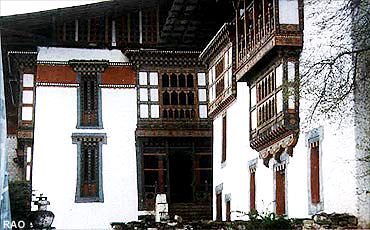|
Special
characteristics of Bhutanese architecture |
 |
Temple of Kurjey Lhakhang near Jakar, Bumthang
| The
eleven-day annual In Bhutanese architecture, there is generally no planning
and designing done on paper before a structure is built. The chief carpenter
is the master of work and he has the size, layout and structure in his
mind. He uses parts of his body for measurement and proportions of the
different features of the building. He supervises other carpenters, stone-cutters
and village workers. |
|
No
nails are used and the wood pieces are assembled by the dovetail technique.
The many examples of traditional Bhutanese architecture that we see were
all built in this way. Architectural styles differ from place to place
and from different periods in time. The differences in style are due to:
-availability of building materials; -physical and climatic conditions;
-social and economic development; -religious and cultural traditions.
The
main materials used have been stones, compressed earth (mud), wood and
bamboo. Stone or rock is mostly used for dzongs and religious buildings
while village houses are made of stones and compressed earth. Wooden shingles
are commonly used for roofing. In some parts of eastern Bhutan bamboo mats
are also used for roofing. Wood is used especially for windows, balconies
of dzong buildings and temples. Windows have a distinctive trefoil shape
and elaborate lintels painted with geometrical and floral motifs. The characteristics
of Bhutanese architecture are generally: -lavish use of wood; -sloped whitewashed
walls; -window size increasing with the stories; -the trefoil shaped windows;
-the pitched roof covered with shingles and weighed down with stones.
Once
the building is completed, artists often embellish it by painting different
auspicious motifs. The selection of the site for any building, as well
as the different steps of the construction, are guided by the astrologer's
calculations and always followed by rituals. For religious buildings, the
configuration of the site and good omens are considered very important.
|



